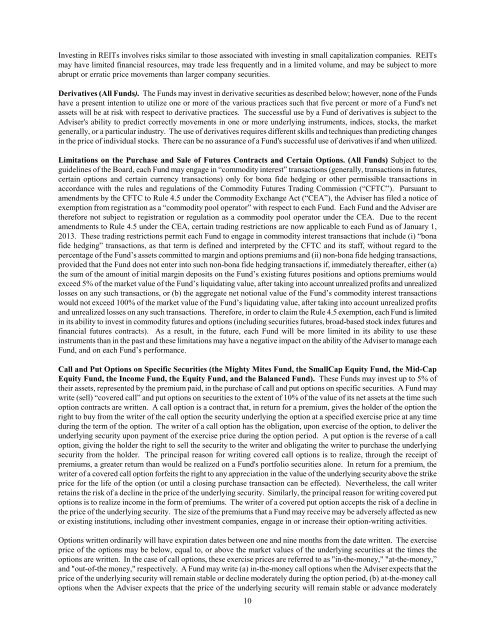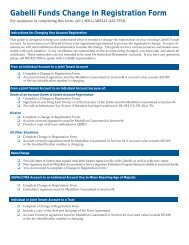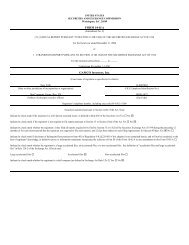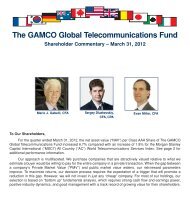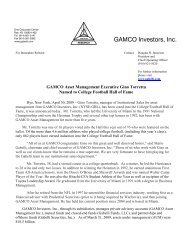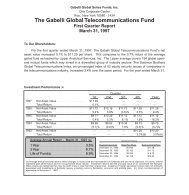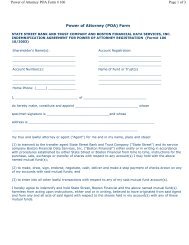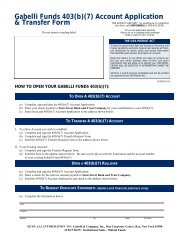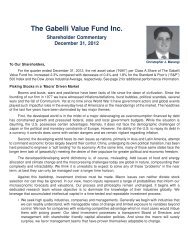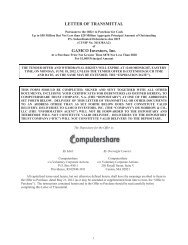Statement of Additional Info - Gabelli
Statement of Additional Info - Gabelli
Statement of Additional Info - Gabelli
You also want an ePaper? Increase the reach of your titles
YUMPU automatically turns print PDFs into web optimized ePapers that Google loves.
Investing in REITs involves risks similar to those associated with investing in small capitalization companies. REITs<br />
may have limited financial resources, may trade less frequently and in a limited volume, and may be subject to more<br />
abrupt or erratic price movements than larger company securities.<br />
Derivatives (All Funds). The Funds may invest in derivative securities as described below; however, none <strong>of</strong> the Funds<br />
have a present intention to utilize one or more <strong>of</strong> the various practices such that five percent or more <strong>of</strong> a Fund's net<br />
assets will be at risk with respect to derivative practices. The successful use by a Fund <strong>of</strong> derivatives is subject to the<br />
Adviser's ability to predict correctly movements in one or more underlying instruments, indices, stocks, the market<br />
generally, or a particular industry. The use <strong>of</strong> derivatives requires different skills and techniques than predicting changes<br />
in the price <strong>of</strong> individual stocks. There can be no assurance <strong>of</strong> a Fund's successful use <strong>of</strong> derivatives if and when utilized.<br />
Limitations on the Purchase and Sale <strong>of</strong> Futures Contracts and Certain Options. (All Funds) Subject to the<br />
guidelines <strong>of</strong> the Board, each Fund may engage in “commodity interest” transactions (generally, transactions in futures,<br />
certain options and certain currency transactions) only for bona fide hedging or other permissible transactions in<br />
accordance with the rules and regulations <strong>of</strong> the Commodity Futures Trading Commission (“CFTC”). Pursuant to<br />
amendments by the CFTC to Rule 4.5 under the Commodity Exchange Act (“CEA”), the Adviser has filed a notice <strong>of</strong><br />
exemption from registration as a “commodity pool operator” with respect to each Fund. Each Fund and the Adviser are<br />
therefore not subject to registration or regulation as a commodity pool operator under the CEA. Due to the recent<br />
amendments to Rule 4.5 under the CEA, certain trading restrictions are now applicable to each Fund as <strong>of</strong> January 1,<br />
2013. These trading restrictions permit each Fund to engage in commodity interest transactions that include (i) “bona<br />
fide hedging” transactions, as that term is defined and interpreted by the CFTC and its staff, without regard to the<br />
percentage <strong>of</strong> the Fund’s assets committed to margin and options premiums and (ii) non-bona fide hedging transactions,<br />
provided that the Fund does not enter into such non-bona fide hedging transactions if, immediately thereafter, either (a)<br />
the sum <strong>of</strong> the amount <strong>of</strong> initial margin deposits on the Fund’s existing futures positions and options premiums would<br />
exceed 5% <strong>of</strong> the market value <strong>of</strong> the Fund’s liquidating value, after taking into account unrealized pr<strong>of</strong>its and unrealized<br />
losses on any such transactions, or (b) the aggregate net notional value <strong>of</strong> the Fund’s commodity interest transactions<br />
would not exceed 100% <strong>of</strong> the market value <strong>of</strong> the Fund’s liquidating value, after taking into account unrealized pr<strong>of</strong>its<br />
and unrealized losses on any such transactions. Therefore, in order to claim the Rule 4.5 exemption, each Fund is limited<br />
in its ability to invest in commodity futures and options (including securities futures, broad-based stock index futures and<br />
financial futures contracts). As a result, in the future, each Fund will be more limited in its ability to use these<br />
instruments than in the past and these limitations may have a negative impact on the ability <strong>of</strong> the Adviser to manage each<br />
Fund, and on each Fund’s performance.<br />
Call and Put Options on Specific Securities (the Mighty Mites Fund, the SmallCap Equity Fund, the Mid-Cap<br />
Equity Fund, the Income Fund, the Equity Fund, and the Balanced Fund). These Funds may invest up to 5% <strong>of</strong><br />
their assets, represented by the premium paid, in the purchase <strong>of</strong> call and put options on specific securities. A Fund may<br />
write (sell) “covered call” and put options on securities to the extent <strong>of</strong> 10% <strong>of</strong> the value <strong>of</strong> its net assets at the time such<br />
option contracts are written. A call option is a contract that, in return for a premium, gives the holder <strong>of</strong> the option the<br />
right to buy from the writer <strong>of</strong> the call option the security underlying the option at a specified exercise price at any time<br />
during the term <strong>of</strong> the option. The writer <strong>of</strong> a call option has the obligation, upon exercise <strong>of</strong> the option, to deliver the<br />
underlying security upon payment <strong>of</strong> the exercise price during the option period. A put option is the reverse <strong>of</strong> a call<br />
option, giving the holder the right to sell the security to the writer and obligating the writer to purchase the underlying<br />
security from the holder. The principal reason for writing covered call options is to realize, through the receipt <strong>of</strong><br />
premiums, a greater return than would be realized on a Fund's portfolio securities alone. In return for a premium, the<br />
writer <strong>of</strong> a covered call option forfeits the right to any appreciation in the value <strong>of</strong> the underlying security above the strike<br />
price for the life <strong>of</strong> the option (or until a closing purchase transaction can be effected). Nevertheless, the call writer<br />
retains the risk <strong>of</strong> a decline in the price <strong>of</strong> the underlying security. Similarly, the principal reason for writing covered put<br />
options is to realize income in the form <strong>of</strong> premiums. The writer <strong>of</strong> a covered put option accepts the risk <strong>of</strong> a decline in<br />
the price <strong>of</strong> the underlying security. The size <strong>of</strong> the premiums that a Fund may receive may be adversely affected as new<br />
or existing institutions, including other investment companies, engage in or increase their option-writing activities.<br />
Options written ordinarily will have expiration dates between one and nine months from the date written. The exercise<br />
price <strong>of</strong> the options may be below, equal to, or above the market values <strong>of</strong> the underlying securities at the times the<br />
options are written. In the case <strong>of</strong> call options, these exercise prices are referred to as "in-the-money," "at-the-money,”<br />
and "out-<strong>of</strong>-the money," respectively. A Fund may write (a) in-the-money call options when the Adviser expects that the<br />
price <strong>of</strong> the underlying security will remain stable or decline moderately during the option period, (b) at-the-money call<br />
options when the Adviser expects that the price <strong>of</strong> the underlying security will remain stable or advance moderately<br />
10


